
The types of worms that infect a person's internal organs are called worms (worms). According to statistics, around 30% of the total population today is susceptible to helminth invasion. Worms that poison the body can infect any part of the body. This is dangerous not only for diseases that helminths can provoke. Their presence in the body can be fatal.
To date, helminthiasis can be completely cured not only with drugs, but also folk remedies. Each type has their own treatment methods. Therefore, knowing and understanding the types of worms, as well as the symptoms of parasitic infection, is important in order to take timely action.
Classification of helminthiasis
Parasitic worms fall into two broad groups: intestines and tissues.
The first type lives directly in the intestine. This group includes:
- Roundworms and pinworms;
- Hookworms and lamblia;
- Whipworms and dwarf tapeworms;
- Beef tapeworm and broad tapeworm;
- Pork tapeworm.
Tissue worms can inhabit any organ in the human body and parasitize for many years. These include:
- Cysticercus and trematodes;
- Trichinae and liver fluke;
- Echinococcus and Alveococcus.
roundworm
They are the most common and difficult types of worms that live in the small intestine of an adult or child. Infection with this type of helminth is called ascariasis.
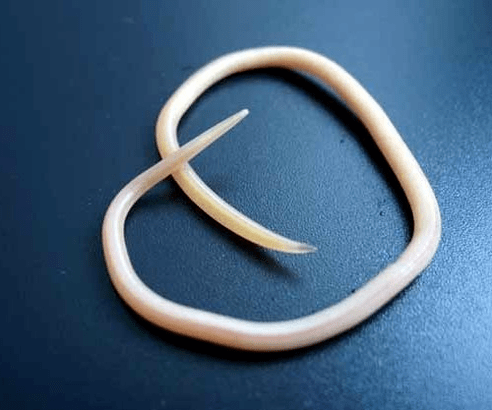
During the first few days of the invasion, a person begins to experience malaise, nervousness, fever, shortness of breath, cough, and chest pain. Such symptoms are justified by the fact that helminths initially affect the respiratory tract.
Infection can occur from drinking raw water from unverified sources, poorly processed fresh fruits and vegetables. In summer the risk of ascariasis is increased.
Pinworms
Small helminths that settle in the intestines cause a disease called enterobiasis. The worms lay their eggs in the anal area. The eggs that are laid turn into larvae and can only get back into the body through the oral cavity.
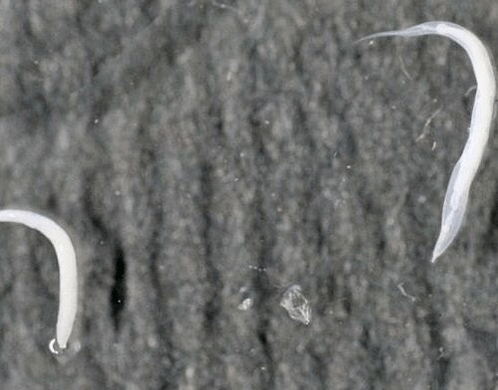
Re-infection occurs when the dirty hands of a person with enterobiasis come into contact with the food they eat. Symptoms of infection may include itching of the anus and increased irritability.
Important! The disease is transmitted from humans.
Hookworm
Hookworm infection occurs through damaged skin on contact with the ground, where the larvae of these types of worms live.
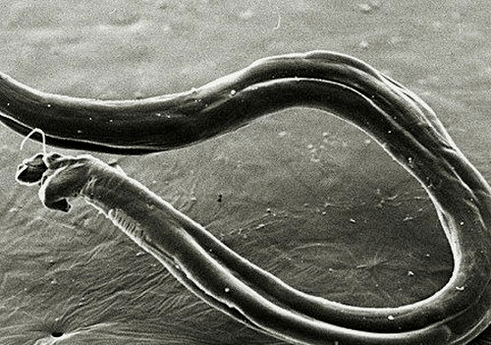
Hookworms follow the same path as roundworms before entering the intestine.
Symptoms include cough, abdominal pain, nausea, and stool disorders. This type of helminthiasis can cause anemia.
Giardia
Giardiasis occurs in people who have a habit of biting nails and other objects (pencils, pens). Infection can also occur from drinking poor quality water, unwashed products, exposure to dirty laundry where larvae may be, and a carrier of the disease.
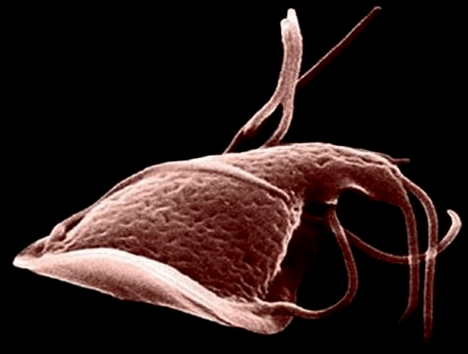
Symptoms of infection can include loose stools and lower abdominal pain.
Vlasoglava
Trichocephalosis occurs during infection with whipworm larvae. They come in along with unprocessed fruits and vegetables. Dirty hands and water are also vectors.
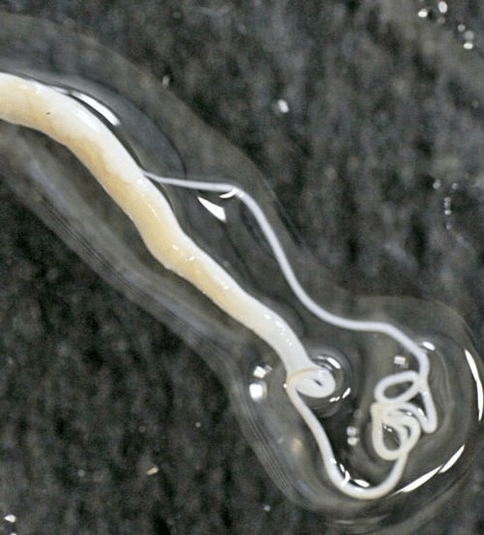
The invasion is accompanied by acute abdominal pain, diarrhea and decreased appetite. Signs of infection often resemble those of appendicitis.
Dwarf tapeworm
Infection with the worm occurs not only through dirty hands and unwashed food, but insects can also be carriers.
Dwarf tapeworm affects the intestines and liver, causing inflammation and poisoning.
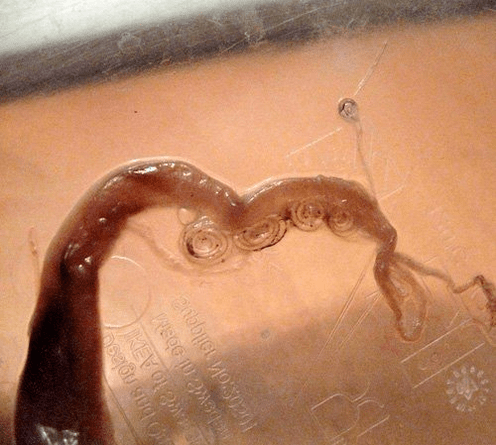
Hymenolepiasis can be accompanied by the appearance of dysbiosis, loss of appetite, increased thirst, increased fatigue and nervousness.
Beef tapeworm
One of the most dangerous types of worms that parasitize the colon.
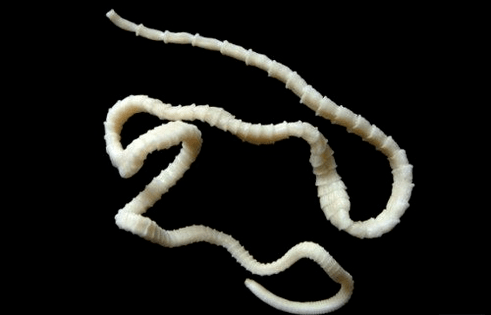
An adult worm can reach a length of several meters. The individual deprives the human body of all nutrients and causes severe poisoning.
The symptoms of the invasion are:
- Diarrhea and abdominal pain;
- Vomiting and nausea;
- restless sleep;
- Dizziness and fainting.
The risk of teniarinhose disease arises from the consumption of underprocessed beef that is contaminated with beef tapeworm larvae.
Broad band
The cause of diphyllobothriasis is the consumption of poorly processed fish products and caviar.
The worm that causes the disease is one of the largest and can reach ten meters.
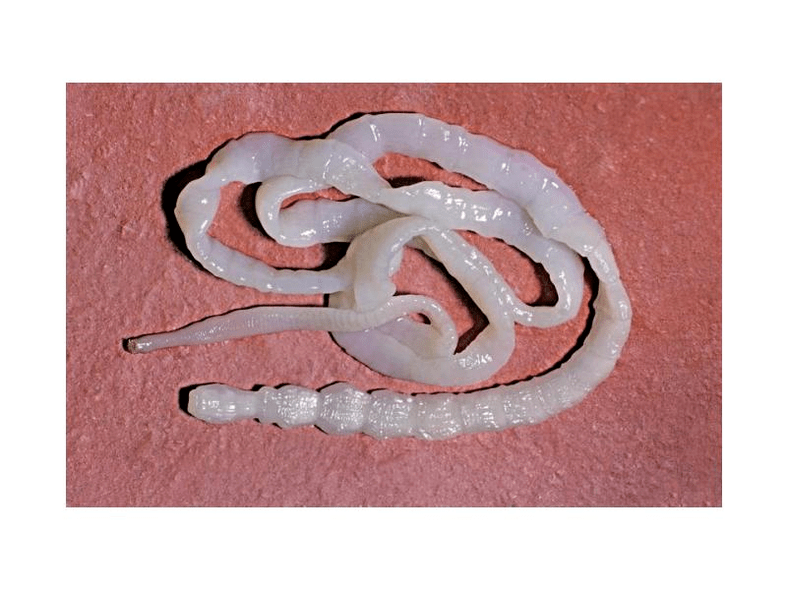
Symptoms of infection are severe pain in the lower abdomen and anemia.
Pork tapeworm
Infection with this type of helminth is extremely dangerous for humans. Eating pork that has not been adequately cooked can cause Finns to invade the body and grow up.
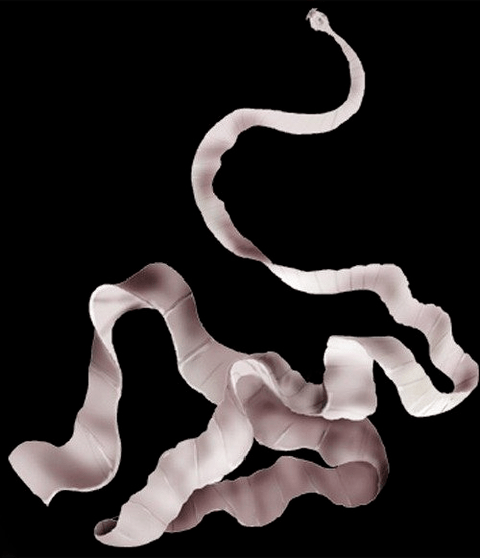
The so-called segments are periodically separated from the body of the pork tapeworm, which the body can independently release into the environment through the anus or with feces. The signs of teniasis are similar to those of a beef tapeworm infection.
Cysticerki
It is a type of tissue worm that is the product of a segment of pork tapeworm. Segments containing tapeworm eggs get into the external environment and can get back into the body through external environmental objects and provoke the development of cysticercosis.

Parasites live in muscles, myocardium, and even the brain.
Important! They squeeze the organs and cause inflammation.
Liver fluke
Opisthorchiasis occurs when the liver fluke larvae are ingested into the human body along with the infected fish.

Signs of the presence of opisthorchiasis:
- Nausea;
- Diarrhea;
- Pain all over the body;
- the occurrence of allergies.
More serious symptoms are chronic. This type of parasite is dangerous for developing liver cancer.
Echinococcus
The worm settles in the body, mostly in the liver or lungs. Echinococcus can cause a cyst to form in the affected organ and cause tumors to appear. Infection can be fatal.
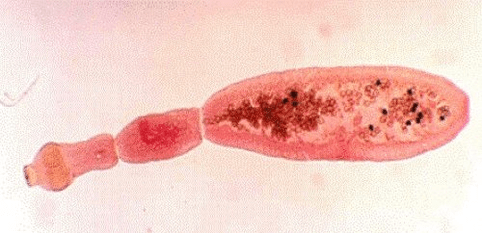
The larvae are transmitted to humans through contact with sick animals.
Trichinella
Trichinosis primarily affects people who eat poorly processed meat from wild animals. Pigs can also carry trichinae.

The habitats of adults in the human body are different types of muscles (respiratory system, face, etc. ).
At an early stage, nausea and loose stools occur. The subsequent symptoms of invasion are fever, edema, rashes, muscle pain. Infection with this type of parasite without timely treatment can be fatal.

Ways of human infection with helminths
- Biohelminthiasis (infection by animals).
- Contagious helminthiasis (transmitted from person to person).
- Geohelminthiasis (diseases caused by parasites performing one of their life cycles on Earth).
Factors affecting the manifestations of helminthiasis
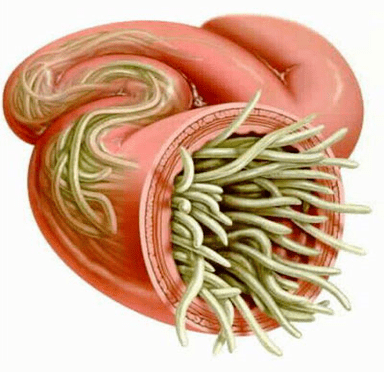
The way the parasite enters the body;
- The degree of adaptation of the helminth to the human body;
- Population density (number) of parasitic individuals;
- The worm's habitat (tissue parasites live in the thickness of soft tissues and luminal parasites in the gaps of hollow organs). Some helminths in different phases have both lumen and tissue shapes. Larval and developmental stages of worms, as a rule, cause more severe pathological changes.
Without re-infection, the number of adult parasites in the human body does not increase. This feature significantly differentiates helminthic invasions from diseases caused by bacteria, viruses, fungi, and protozoa.
Worms in humans: symptoms
Helminthiasis is a disease that is characterized by two stages of course (acute, from two weeks to two months) and chronic (from several months to several years).
Symptoms of the acute phase of helminthiasis
The first signs of the disease can appear at different times (most often after 2-3 weeks with ascariasis - after 2-3 days and with filariasis, the incubation period can last 6-18 months).
In the acute stage of parasitic invasion, the most characteristic symptom is an allergic reaction (antibodies are produced against the antigens of migrating parasite larvae). People who are infected with worms often experience itchy rashes on the skin, which tend to recur, increase regional lymph nodes, generalized or local edema, muscle and joint pain can occur. In addition, migrating parasite larvae can cause chest pain, coughing, attacks of suffocation, stool disorders, nausea and vomiting.
Signs of chronic helminthiasis
The symptoms of the chronic phase depend directly on which organ is "inhabited" by the parasite, and their size and number also play an important role.
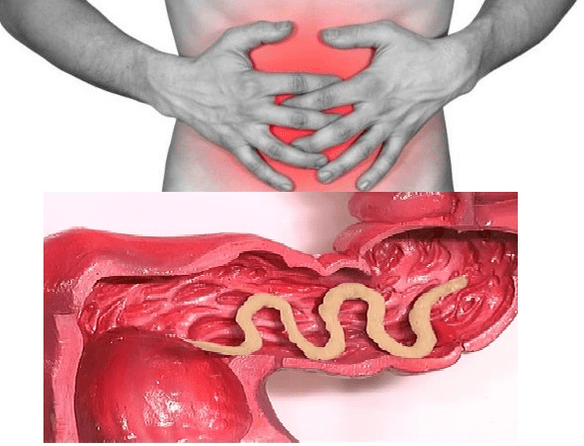
So if individuals parasitize in the intestine, the disease can be asymptomatic (with the exception of cases of infection with very large parasites). The characteristic signs of the chronic phase of intestinal helminthiasis are dyspeptic disorders. In children, the asthenoneurotic and pain syndrome are more pronounced. With a massive invasion of roundworms, the development of intestinal obstruction, obstructive jaundice and pancreatitis is possible.
In people suffering from helminthiasis, the risk of malignant tumors increases significantly due to a weakened immune system and an increased cell division process (a result of the constant restoration of tissues damaged by parasites).
Types of helminths that parasitize in the human body
The causative agents of human helminthiasis are two types of worms: round (nematodes) and flat (duct tape and leeches).
Round worms
Pinworm
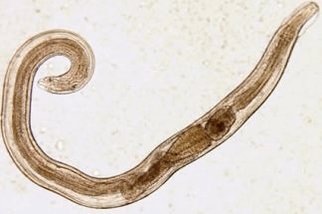
The parasites that cause enterobiasis are small (up to 10 mm) thin cavity worms with a gray-white color. Infection occurs through food (through the mouth). The reason for this is dirty hands. The eggs of the parasite are in the ground, on the wool of infected animals, unwashed vegetables and fruits, etc. At the same time, with enterobiasis, cases of self-infection often occur (especially in children), due to scratching the itchy areas and subsequent swallowing of eggs. The pinworm larva develops in the digestive tract within two weeks. After the worm grows up, it parasitizes in the lower sections of the small and upper parts of the large intestine.
Ascaris
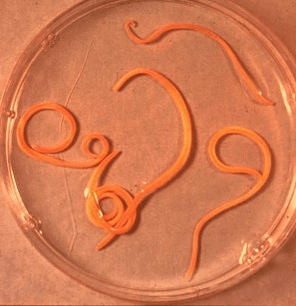
Ascaris is a large spindle-shaped parasite of red-yellow color that reaches 40 cm (women) and 15-25 cm (men) in adulthood. Without suction cups or other fastening devices, the roundworm can move independently in the direction of the mass of food. The eggs laid by the female of the parasite are excreted with the faeces.
Vlasoglav
Vlasoglav, the causative agent of trichocephalosis, is a white helminth that parasitizes in the initial section of the large intestine and reaches a size of 4 to 5 cm. The parasite feeds on blood and tissues of the rectal mucosa.
With a small number of worms, trichocephalosis is asymptomatic. At a severe stage (with massive invasion), the patient develops abdominal pain, severe diarrhea develops, sometimes accompanied by rectal prolapse. This condition is most often seen in debilitated children. With a moderate phase of trichocephalosis, growth retardation of a child is possible.
Trichinella
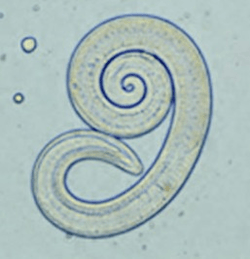
The causative agent of trichinosis is a small round helminth with a length of 2-5 mm. Infection occurs when poorly roasted meat (pork, bear meat, wild boar) is eaten. The larva of the parasite penetrates the intestines and matures in 3-4 days to the state of a sexually mature individual. The lifespan of the worm is 40 days, after which the parasite dies. By piercing the intestinal wall, the larvae enter the bloodstream and are transported to all organs in the human body, settling in the muscles. In this case, the muscles of the respiratory and facial muscles, as well as the flexors of the limbs, are most often affected.
In the first few days after the invasion, patients complain of abdominal pain. Then, after about 2 weeks, the body temperature rises to 39-40 ° C, itchy rashes appear on the skin, muscle pain develops, and the face swells. During this time, there is a significant risk of death if there is a massive infection. After about a month, the patient will recover. The parasite is encapsulated in a spiral and dies within two years.
Hookworm and nekator
These two parasites are similar in their biological properties as well as the diseases they cause. In this regard, it is common to combine them under a common name (hookworms). Worms that reach 10-15 mm in length parasitize in 12-p. Intestines. It should be noted that this is one of the most common, but at the same time quite rarely discovered parasites. Worm larvae enter the human body through the skin through contact with contaminated soil. When they enter the bloodstream, they travel like roundworms to the lungs and then along with the sputum through the bronchi to the digestive tract. The ankylostoma parasitizes in the intestine and attaches itself to the intestinal wall. Therefore, the most characteristic symptom of this helminthiasis is iron deficiency anemia, as well as a change in the ratio of protein fractions (dysproteinemia).
Flat worms
Broad band
This is one of the largest helminths, 10-20 meters in length. The disease caused by this parasite is called diphyllobothriasis. The worm's development cycle begins with freshwater fish or crustaceans. The larva enters the human body along with eggs or infected fish fillets, which is the ultimate owner of the broad tapeworm. The parasite reaches the small intestine, clings to its wall, and grows into a mature individual within 20 to 25 days.
Diphyllobothriasis occurs against the background of digestive tract disorders and B12 deficiency anemia.
Liver fluke
The parasite that causes opisthorchiasis is a flat worm that reaches 7-20 mm in length. Human infection occurs when contaminated fish meat is eaten that has not undergone adequate heat treatment. The larva of the liver fluke from the small intestine penetrates the biliary tract and the gallbladder and fixes itself there with the help of two suction cups.
In the acute phase of helminthiasis, the patient has pain in the upper abdomen, the body temperature rises, nausea, muscle pain, diarrhea and rashes are possible. The chronic course of opisthorchiasis manifests itself in symptoms of hepatitis, inflammation of the biliary tract, cholecystitis, disorders of the digestive tract, nerve disorders, weakness and increased fatigue. The parasite leads to the development of irreversible changes, and even after its expulsion, the patient is not subject to chronic inflammatory processes and dysfunction.
Bovine and pork tapeworm
These almost identical parasites reach a length of 5-6 meters. Teniarin pants and teniasis infection occurs as a result of consuming cattle or pork meat that has been infected by the Finns (one of the intermediate forms of helminthiasis). Viable fins, presented in the form of whitish bubbles 0. 5 cm in size, attach to the wall of the human small intestine and grow up in 3 months. The ribbon parasite, which consists of more than 2000 segments, is constantly growing.
Echinococcus
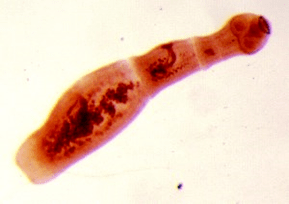
For this parasite, a person is an intermediate host. The worm parasitizes the human body in the form of fins. The last owner of Echinococcus is a wolf, dog or cat. Infection occurs through contact with animals and with environmental objects that are sown with Echinococcus eggs. After entering the intestine, oncospheres (larvae with six hooks) develop from them. They enter the bloodstream from the intestine and are transported through the body.
Alveococcus
This parasite, considered a type of echinococcus, is the cause of one of the most dangerous helminthiasis (alveococcosis), the severity of which is similar to cirrhosis and liver cancer. Infection occurs when oncospheres (eggs with mature larvae) enter the intestines. Laurocysts are very aggressive formations that constantly grow due to expanding bladders and, like cancer metastases, can also grow into the liver. Necrotic changes due to dysfunction of blood vessels are subject to necrotic changes in nearby tissues. The alveococcus spreads to nearby structures and forms fibrous nodes with inclusions of multi-chambered bubbles. This condition can persist for several years, so it requires mandatory surgical intervention.
Diagnosis of helminthiasis
Diagnosing helminth invasion involves the following activities:
- careful collection of anamnesis to find out the possible causes of infection;
- Laboratory tests of feces, blood, intestinal contents 12p, rectal and perianal mucus, muscle tissue, lung sperm, bile. The analysis can reveal eggs, segments or fragments of parasites. At the same time, an increased level of eosinophils in the blood is also a signal of the presence of helminthiasis.
- When diagnosing diseases caused by larval stages or tissue parasites, serological tests are carried out (ELISA, RSK, indirect agglutination reaction, immunofluorescence analysis, etc. ).
- To identify worms that affect liver tissue, ultrasound, CT and endoscopic examinations are prescribed.
Worms in humans: treatment
In the acute phase of parasitic infection, the patient is prescribed detoxification and desensitization therapy. In severe cases of illness (liver trematodes, trichinosis), glucocorticoids are used according to medical indications.
As a drug of specific therapy, taking into account the nature of the pathogen, special anthelmintic chemotherapy drugs are prescribed.
In parallel, the patient is recommended to take antihistamines and enterosorbents. The final stage of treatment includes the use of probiotics, which normalize the intestinal flora.
A special gentle diet is also prescribed (foods should be digestible and low in fat).
During anthelmintic therapy, the patient must strictly observe personal hygiene (to avoid re-infection). At the same time, with many helminthiasis, all family members and people who are in constant contact with the infected must be treated.
An underestimation of their danger, combined with a lack of awareness of the biology of these creatures and the nature of the infection with them, has resulted in at least several billion people today being carriers of certain parasites.
Parasites can also be present not only inside a person but also outside the human body.
Parasite Infestation Prevention
Rule 1:You cannot eat fish that is not sufficiently salted, fried, or cooked. Sushi, lightly salted herring, or sashimi can all be considered gourmet food. However, it is essentially raw fish and fish is one of the parts of the parasitic worm life cycle.
How it all happens:First the larva enters the mollusk, where it does not grow more than a certain limit, then the fish eats the mollusk, the larva enters its digestive tract, stays alive, grows and multiplies, and gets into the muscular tissue of the fish. then this fish is eaten by a dolphin, a seagull or a polar bear. Or a restaurant visitor who joins the high Japanese culture.
In theory, there is safe raw fish. To do this, it must either be frozen immediately after being caught and thawed just before cooking, or it must be specially grown on a fish farm to control the absence of parasites. But it is usually impossible to check whether a risky dish was actually made from it.
The same caution should be exercised with meat. Don't try raw ground beef or freshly salted bacon.
In addition, in order not to get infected with helminths, it is necessary to wash vegetables and hands before eating. As part of the natural environment, these parasites are found almost everywhere in the human body.
Any contact of food or hands with the ground, dirt dust and vegetation can leave their microscopic eggs on food. When they get into the intestines, worms hatch from the eggs and are not easy to remove.
There are parasites that attack a person who is walking or relaxing in nature, for example:
- Malaria plasmodium, contained in the saliva of mosquitoes of the genus Anopheles,
- the causative agent of encephalitis in the saliva of ixodid ticks,
- Gadfly and Wolfarth fly.
Their prevention consists in the use of all types of repellants when hiking in the wild, as well as in the maximum protection of open body areas (mosquito nets, nets, special gel).
But what can you do when prevention hasn't worked? Since the attack has long been known, treatment with folk methods has also long been known.
In summary, it can be stated that compliance with simple hygiene and hygiene regulations, the extermination of flies and cockroaches can significantly reduce the risk of infection with parasites and have serious consequences.
























